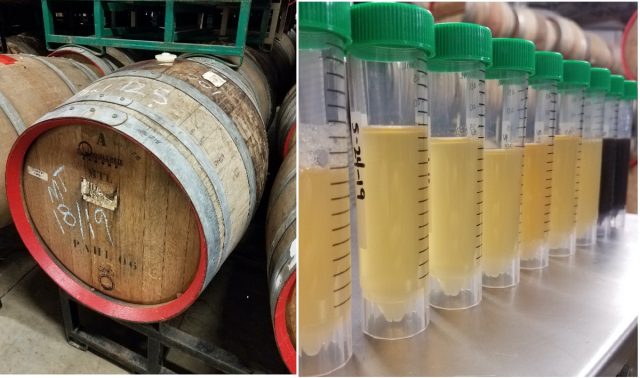Sour beer has been around for centuries and has become a favorite with craft brewers in recent years. But the brewing process can be unpredictable. To help brewers better understand how sour beers develop their distinctive complex flavors, chemists at the University of Redlands in California have been tracking various chemical compounds that contribute to those flavor profiles, monitoring how their concentrations change over time during the aging process. They presented their initial findings during the American Chemical Society's Fall 2020 Virtual Meeting & Expo last week.
Goses, lambics, and wild ales, oh my!
Brewers of standard beer carefully control the strains of yeast they use, taking care to ensure other microbes don't sneak into the mix, lest they alter the flavor during fermentation. Sour beer brewers use wild yeasts, letting them grow freely in the wort, sometimes adding fruit for a little extra acidity. Then the wort is transferred to wooden barrels and allowed to mature for months or sometimes years, as the microbes produce various metabolic products that contribute to sour beer's unique flavor. But the brewers don't always know exactly which compounds end up in the final product or how it will impact the overall flavor profile. "That is the quandary of the sour beer brewer," said co-author David Soulsby during a virtual press conference.
"Sour beer tastes very different from regular beer, but it's a very complex and rich flavor experience. These different flavors come from the complex processes that are occurring during aging," said co-author Teresa Longin, who also happens to be married to Soulsby. "These processes are hard to control and can be hard to reproduce. Our research focuses on understanding what these processes are, what's happening over time, so that the brewer can ultimately understand them and make better beer."
Longin and Soulsby became interested in the subject about six years ago, when Soulsby decided to spend his sabbatical investigating the composition of commercial sour beers and convinced Longin that her experience would benefit the study. It soon blossomed into a bigger research project. Last year the duo partnered with Bryan Doty, a master brewer at Sour Cellars in nearby Rancho Cucamonga, California, who provided several samples from his own sour beers.
"Scientists are very interested in beer and especially sours because they are such complicated systems," said Longin. "There have been several prior studies of the components in finished sour beers. What makes our study different is that we've been able to get samples of beer in progress from many different batches."
With an undergraduate, Alexis Cooper, Soulsby tracked the aging process in nine batches of Doty's sour beer, collecting about 15 samples per batch, from a particular barrel, every two to four weeks over the course of a year. Using NMR spectroscopy, they studied the levels of acetic acid, lactic acid, and succinic acid, all of which are produced as the yeast ferments and contribute to the distinctive flavor profile of a sour beer. "The balance of organic acids produces very different types of sour beer," Longin said. "It can be more like balsamic vinegar, which has a sweet/sour flavor, or it can be 'puckery' sour. So the mix of organic acids is really important for understanding the flavor profile."
Soulsby tracked how these compounds changed over time for each batch of beer. He found that even though Doty's batches followed similar recipes, there was still considerable variation in the rate of development of the compounds. "The responsible bacteria can take a while to establish themselves, which is what we believe is behind these results," said Soulsby. "But the barrels themselves also appear to be important contributors to this variation."
Meanwhile, Longin and another undergraduate, Emily Santa Ana, used liquid chromatography and time-of-flight mass spectrometry to identify and track changes in trace compounds that can also contribute to the overall flavor profile, such as phenolics or vanillin, which can be found in some sour beers. Longin's analysis revealed trace amounts of hordatines, which come from barley and are known to possess antimicrobial properties, as well as the amino acid tryptophan (commonly associated with feeling sleepy after a heavy Thanksgiving turkey dinner, although scientists dismiss this as a myth). While the hordatine levels stay fairly constant over time, Longin found that the tryptophan levels typically decreased over time.

Cloudy with a chance of chemistry
Sour beer sRead More – Source
[contf] [contfnew] 
arstechnica
[contfnewc] [contfnewc]







